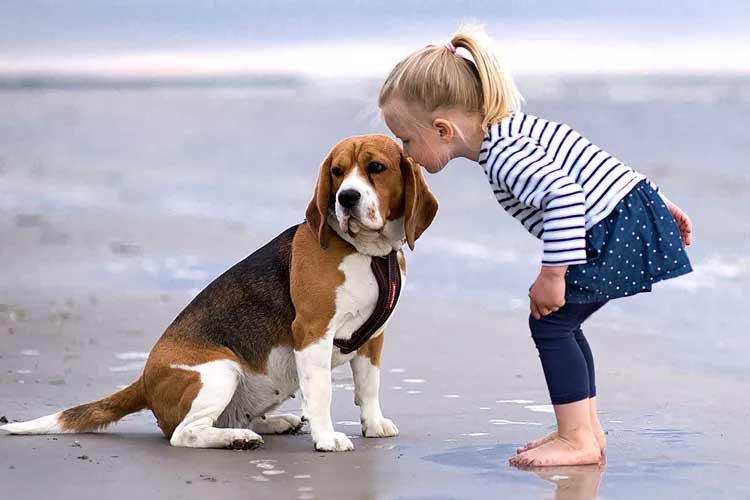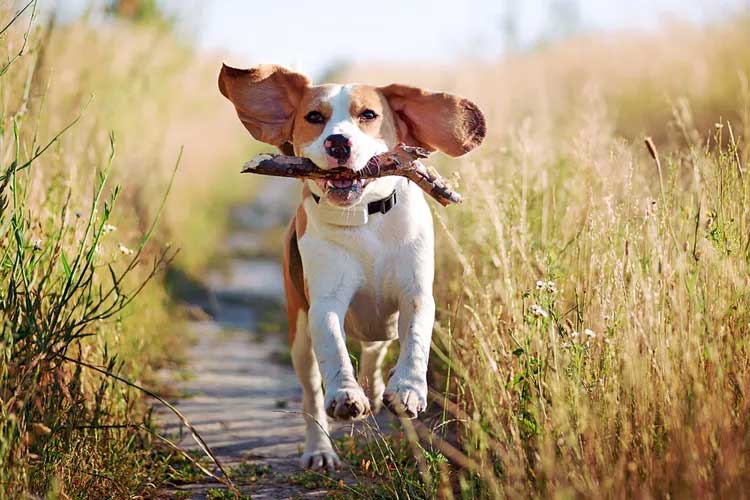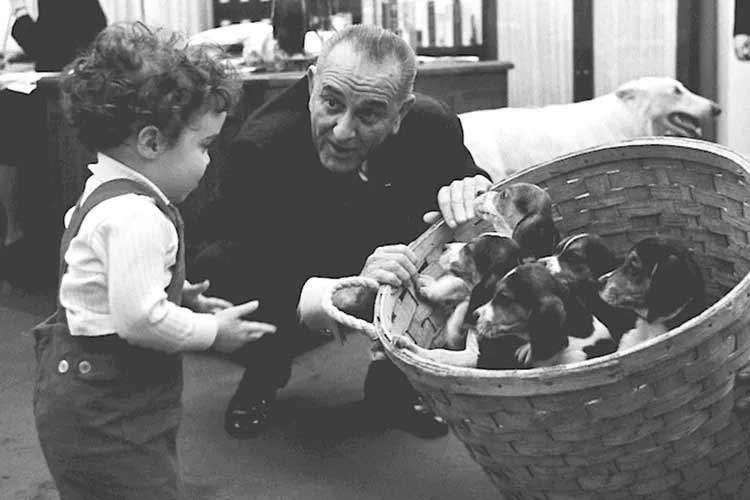Beagles are gentle, fun-loving hounds who require plenty of exercise and companionship with their owners. Learn more about living with this family breed.

Beagle Overview
| OFFICIAL NAME | Beagle |
| COMMON NAME | Beagle |
| PET HEIGHT | 13 to 15 inches |
| PET WEIGHT | 20 to 30 pounds |
| LIFESPAN | 10 to 15 years |
| GOOD WITH | cats, children, dogs, families |
| TEMPERAMENT | friendly, gentle, outgoing, playful, willful |
| INTELLIGENCE | medium |
| SHEDDING AMOUNT | frequent |
| EXERCISE NEEDS | high |
| ENERGY LEVEL | active |
| VOCAL LEVEL | howler |
| DROOL AMOUNT | low |
| BREED GROUP | hound |
| BREED SIZE | small (0-25 lbs.) |
| COAT LENGTH | short |
| COLORS | black, brown / chocolate / liver, gold / yellow, red |
| PATTERNS | bicolor, flecked / ticked / speckled, saddle / blanket, tricolor |
| OTHER TRAITS | apartment-friendly, cold weather tolerant, easy to groom, good hiking companion, high potential for weight gain, high prey drive, tendency to chew |
Beagles are gentle, fun-loving hounds who enjoy long meandering walks followed by plenty of down time next to their owners. Small in stature, beagles were bred to be hunting dogs and to this day are led by their nose. Their sharp sense of smell makes them a top choice for small-game hunters, and you'll often see them employed as detection dogs searching for contraband at U.S. borders.
Beagles require plenty of daily exercise and can fit in well with active families. These petite pups have long been a favorite of American families and currently rank as the seventh most popular breed in the U.S.
Appearance
Easily recognizable by her big brown eyes and square, floppy ears, the beagle is a popular small to mid-sized hound breed. There are technically two types of beagles: A smaller version weighing 20 pounds and under; and a slightly larger, 20- to 35-pound version. Their bodies are small but mighty and pack plenty of power.But whether she's smaller in stature or a medium-sized dog, all beagles have a short, smooth double coat. They come in a myriad of colors, but are most frequently seen in a tricolor coat of black, tan, and white or blue, tan, and white. Other colorways, according to the National Beagle Club of America, are: tan and white; lemon and white; red and white; and chocolate and white.
Their thick coats are prone to moderate shedding throughout the year, with a heavy shedding season each spring. Beyond frequent brushing to keep those short hairs under control (and off of your couch, clothes, and floor), these popular hounds are pretty low-maintenance pups.
Temperament
Friendly, playful, and compact, it's no wonder the beagle has long been a family favorite. These high-energy hounds need plenty of daily exercise, but once properly exhausted they're more than happy to hang at home with their people.Beagles love to play. They make great companions for children and do well with cats and other dogs. As with any breed, it's important to properly socialize your beagle from a young age so she can learn to play nicely and not get too rough. It's also important to teach children how to properly interact with dogs and always supervise them when playing with any dog.

It's no surprise beagles are loud. "We bred that into them," says Brian Kilcommons, founder of The Great Pets Resort, a training facility in Connecticut. "When a beagle is running in the field in those big circles, the baying does two things: One, it spooks the rabbits out of hiding, and two, it lets the hunter know where the dog is."
Because of their tendency to bark, beagles can make good alert systems, letting their owners know the moment a neighbor or delivery man starts walking up to the house—just don't expect them to follow up with anything other than a welcoming wag of the tail. Because of their noise level and high prey drive, this breed can become a handful if not properly trained and cared for. These pack hounds are also happiest with company and shouldn't be left alone for too long. If your beagle becomes lonely or bored, she will howl for hours on end.
Beagles are smart, curious dogs, but don't expect them to immediately obey your every command—she'd much rather follow her nose and explore than sit on queue. It's very possible to train a beagle, but it will require lots of patience and consistent positive reinforcement training sessions. Make sure you have plenty of treats on hand, because what may take certain breeds 20 minutes to learn, "with a beagle you're probably talking about two weeks," Kilcommons says.
But once she's well-trained, a beagle makes a great and obedient dog. Coupled with their fine-tuned sense of smell and friendly faces, this breed is favored by the United States Department of Agriculture at airports and entry points across the country.
"Beagles were bred to have their nose on the ground, get a scent, and follow it—the brain basically goes into overdrive on scent work," Kilcommons says.
Living Needs
Bred as scent hounds that hunt in packs, beagles are notorious for always having their heads to the ground, searching for the next best scent to follow. Because of this, beagles must be in a home with a properly secured—and ideally reinforced—fence or have plenty of access to the outdoors for long, meandering walks on a lead. Because of her wandering nose, it's important to keep an eye on your beagle whenever she's outdoors and get her microchipped. She might just follow a smell right out of your backyard!Despite being a smart breed, beagles are notoriously slow to house train and may take up to a year to be accident-free. Kilcommons says it's highly encouraged to practice crate training with a beagle and to stay positive, patient, and consistent during any training.

A beagle is at her happiest with an owner who will play to her scent tracking strengths—whether through hunting, competitions, or hours-long hikes or walks around the neighborhood—and can spend plenty of quality time by their side. Beagles are prone to loneliness, and when left alone for too long or not properly exercised and trained, she can develop undesirable behaviors.
It's important to consider your lifestyle before committing to any dog. Talk to a beagle breeder or rescue group to see if this houndis a good fit for your family.
Care
The beagle's short, weather-proof coat is easy to maintain, but comes with a price—it's prone to frequent shedding. Brushing your beagle two to three times a week will keep dead hair from building up in your home and promote new, healthy hair growth. Because she has a double coat, she'll shed heavily in the spring and you'll want to increase your brushing routine to daily.
Beagles rarely need baths, unless they're getting into messy situations. Regular grooming is a good opportunity to check for things like coat sheen (dull hair can mean a lack of nutrients in her diet), nail length, and ear and dental health. Her nails should be trimmed frequently—if you can hear them tapping against the floor, they're too long.
Like most hounds, beagles will require weekly ear care, as their long and floppy shape can prevent proper air circulation and lead to infections. It's important to talk to your veterinarian about the proper way to check and clean your beagle's ears.
Using food is a surefire way to get your beagle's attention during training, but beware of becoming seen as a buffet. "It's easy for the relationship to be with the food, not the person," Kilcommons says. "After the dog understands what's expected, I expect a response and I'm not going to dress like a deli. They'll do what we want, and they're looking for it, but in order to get that you have to reward them in such a way that makes it worth it. You need to be enthusiastic. Tell him how smart he is, smile at him, and look at the gauge: The tail. That'll tell you if it's working."
Health
The beagle is considered a generally healthy breed with a lifespan of 10–15 years. But like all breeds, beagles can have certain health issues.Beagles are susceptible to a breed-specific condition called Musladin-Lueke Syndrome (MLS). This is a genetic disease affecting connective tissue and can affect nearly everything in their body: Organs, bones, skin, and muscle. Signs of MLS include:
Small size
Thick and taut skin
Reduced joint mobility
Broadened skull with wide-set, slanted eyes
Abnormal "tip-toe" gait
The NBCA, the official breed club, requires registered breeders to test for MLS, hip dysplasia, and to complete a thorough eye exam. The club also recommends screening for autoimmune thyroid disease and cardiac issues.

Of course, not all beagles will encounter serious health issues, but it's important to be aware of these common concerns when considering this breed. It's also important to purchase all dogs from reputable breeders who will introduce you to the dog's parents and siblings. If adopting, ask the rescue for all available health history.
Beagles also have a big appetite and are prone to obesity. It's important to ensure you properly measure each meal and factor in any training treats and in-between snacking. This high-energy breed needs at least an hour of exercise each day, and long walks help keep them fit physically and mentally.
History
Where and when the beagle breed originated is uncertain and up for debate. According to the NBCA, beagle-like dogs can be traced back to reports in 200 A.D. England. Other stories trace the beagle's ancestors farther back to ancient Greece.The breed's name tells an entirely different story, with two widely backed origin theories: Gaelic (in which beag means "little") and French (in which be'geule is the term for the howls hounds make when hunting). Though it's generally believed the modern-day beagle resulted from centuries of breeding between European and British hounds and share ancestors with the foxhound and the now-extinct Southern hound.

The similarly small ancestral hounds were used by English gentlemen to track rabbits and hares. As that prey is often hunted by foot rather than horse, the beagle quickly became a favorite among common trackers. Variations of the breed intrigued the English royalty and it's reported, the NBCA says, that Queen Elizabeth I kept packs of "pocket beagles," a 9-inch-tall beagle that's said to fit in a pocket.
Beagles were further refined and standardized in England and Scotland in the 1800s, resulting in the beagle you see today. The breed as we know it didn't make its official appearance stateside until after the Civil War when U.S. breeders began importing English beagles. On this side of the pond, the breed's popularity was instant. The beagle was recognized by the American Kennel Club in 1885, and the breed is currently the seventh most popular in the U.S.
Fun Facts
Snoopy, from the long-running Peanuts comic strip, is perhaps the most famous beagle in the world. The Snoopy character was inspired by the Schulz's family dog, Spike.The beagle's white-tipped tail actually serves a purpose. When out hunting, the white makes it easier to track through the woods and tall grass—like a little white flag bobbing through the brush!
Lyndon B. Johnson had three beagles in the White House during his presidency: Him, Her, and Edgar.
Beagles have had starring roles in many big screen productions, most famously Cats & Dogs, Shiloh, and John Wick, where the entire plot of the film revolves around the titular character's beloved beagle puppy Daisy.